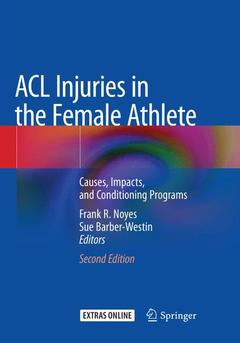ACL Injuries in the Female Athlete (2nd Ed., Softcover reprint of the original 2nd ed. 2018) Causes, Impacts, and Conditioning Programs

This successful book, now in a revised and updated second edition, reviews all aspects of anterior cruciate ligament (ACL) injuries in female athletes, with the focus on complete, noncontact ACL injuries. The opening section discusses anatomy and biomechanics and explains the short- and long-term impacts of complete ACL ruptures, including long-term muscle dysfunction and joint arthritis. Risk factors and possible causes of the higher noncontact ACL injury rates in female athletes compared with male athletes are then discussed in depth. Detailed attention is devoted to neuromuscular training programs and their effectiveness in reducing noncontact ACL injury rates in female athletes, as well as to sports-specific ACL injury prevention and conditioning programs of proven value. Rehabilitation programs after ACL injury and reconstruction that reduce the risk of a future injury are explored, and the concluding section looks at worldwide implementation of neuromuscular ACL injury prevention training and future research directions. The book will be of value to orthopedic surgeons, physical therapists, athletic trainers, sports medicine primary care physicians, and strength and conditioning specialists.
The Impact of ACL Injuries: Short- and Long-Term Effects on the Knee Joint: The ACL: Anatomy, Biomechanics, Mechanisms of Injury, and the Gender Disparity: Consequences of Complete ACL Ruptures.- Muscle Dysfunction after ACL Rupture and Reconstruction: Implications for Successful Recovery.- Risks of Future Joint Arthritis and Reinjury after ACL Reconstruction. Proposed Risk Factors of Noncontact ACL Injuries: Analysis of Risk Factors for Noncontact ACL Injuries.- Role of Shoe-Surface Interaction and Noncontact ACL Injuries.- Gender Differences in Muscular Protection of the Knee.- Neuromuscular Differences Between Men and Women.- Effects of Alterations in Gait Mechanics on the Development of Osteoarthritis in the ACL-Deficient Knee.- Role of the Foot and Ankle in ACL Noncontact Injuries.- Analysis of Muscle Activation Patterns During Running, Cutting, and Jumping.- Role of Core Stability in Preventing Noncontact ACL Injuries.- Role of Hip Strength and Motion in Noncontact ACL Injuries.- Recovery of Hip Muscle Strength after ACL Injury and Reconstruction: Implications for Reducing the Risk of Reinjury.- Gender Differences in Core Strength and Lower Extremity Function During the Single-leg Squat Test.- Gender Effect of Fatigue on Lower Extremity Kinematics and Kinetics During Athletic Tasks.- Tools to Identify Female Athletes at Increased Risk for Noncontact ACL Injury.- Testing for Neuromuscular Problems and Athletic Performance. ACL Injury Prevention Programs: Sportsmetrics ACL Intervention Training Program: Components, Results.- Sports-Specific Programs for Soccer, Basketball, Volleyball, and Tennis.- ACL Injury Prevention in Soccer: The Santa Monica Experience.- ACL Injury Prevention Warm-up Programs.- Effect of Intervention Programs on Reducing the Incidence of ACL Injuries, Improving Neuromuscular Deficiencies, and Enhancing Athletic Performance. Reducing the Risk of Reinjury After ACL Reconstruction: Analysis of Primary Variables That Increase theRisk of Reinjury After ACL Reconstruction.- Rehabilitation After ACL Reconstruction.- Restoration of Proprioception and Neuromuscular Control Following ACL Injury or Surgery.- Functional Assessment of Neuromuscular Function Before Return to Sports After ACL Reconstruction.- Role of Visual-Motor Training and Isokinetic Training and Testing After ACL Injury and Reconstruction. Future Directions: Promotion of ACL Intervention Training Worldwide.- What We Know and Goals for Future Research.
Frank R. Noyes, MD is the founder and CEO of the Cincinnati SportsMedicine and Orthopaedic Center and the President and Medical Director of the Noyes Knee Institute in Cincinnati, Ohio. Prior to founding the Center, Dr. Noyes was Director of the Sports Medicine Institute and was a Professor in the Department of Orthopaedic Surgery at the University of Cincinnati. Dr. Noyes has received numerous awards and honors including the Kappa Delta Research Award from the American Academy of Orthopaedic Surgeons, the Dr. Ernst Jokl Sports Medicine Award from the U.S. Sports Academy, and induction into the American Orthopaedic Society for Sports Medicine’s Hall of Fame. In 2013, he served as President of the Herodicus Society, which is considered the premier group of American, Canadian, and European sports medicine physicians. Dr. Noyes has held numerous editorial board appointments for various leading journals. He has published over 300 articles in peer-reviewed orthopaedic journals and textbooks, is the editor of Noyes’ Knee Disorders: Surgery, Rehabilitation, Clinical Outcomes, 1st and 2nd editions, is co-editor of 12 eBooks that discuss a variety of knee and lower limb conditions, and was noted in 2012 to be one of the most frequently cited authors worldwide in the field of arthroscopic surgery and orthopaedics.
Sue D. Barber-Westin, BS, is Director of Clinical & Applied Research at the Cincinnati Sportsmedicine Research and Education Foundation and the Noyes Knee Institute, a position she has held since 1985. Ms Barber-Westin is an exceptionally experienced clinical research professional specialized in the development, implementation, and completion of outcome studies in orthopaedics and sports medicine. Along with Dr. Noyes, she has conducted over 70 clinical research projects involving 7000 patients and volunteer subjects and has published 180 manuscripts in peer-reviewed orthopaedic journals and textbooks. In 2004, Ms. Barber-Westin and Dr.
Date de parution : 01-2019
Ouvrage de 666 p.
17.8x25.4 cm
Date de parution : 09-2018
Ouvrage de 666 p.
17.8x25.4 cm



